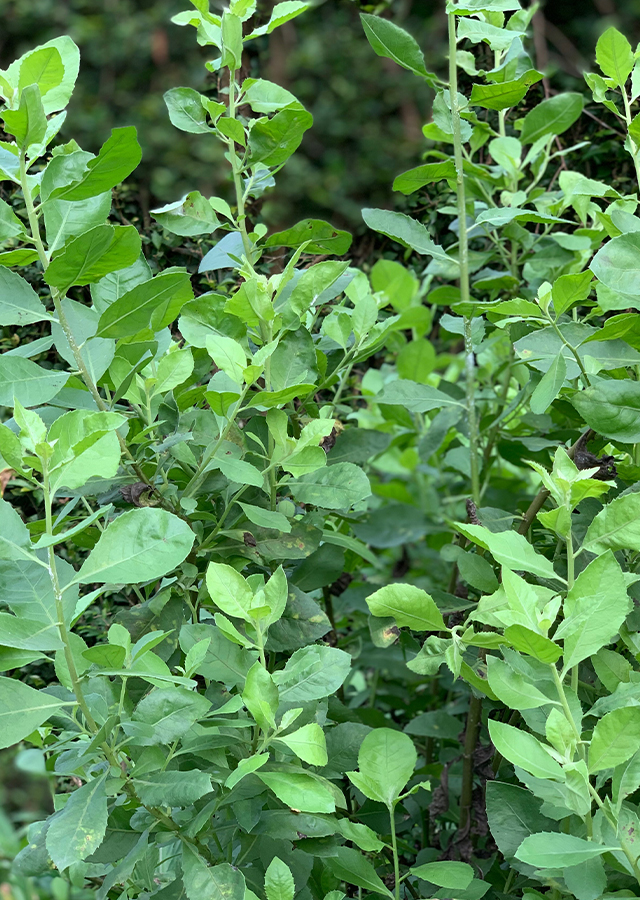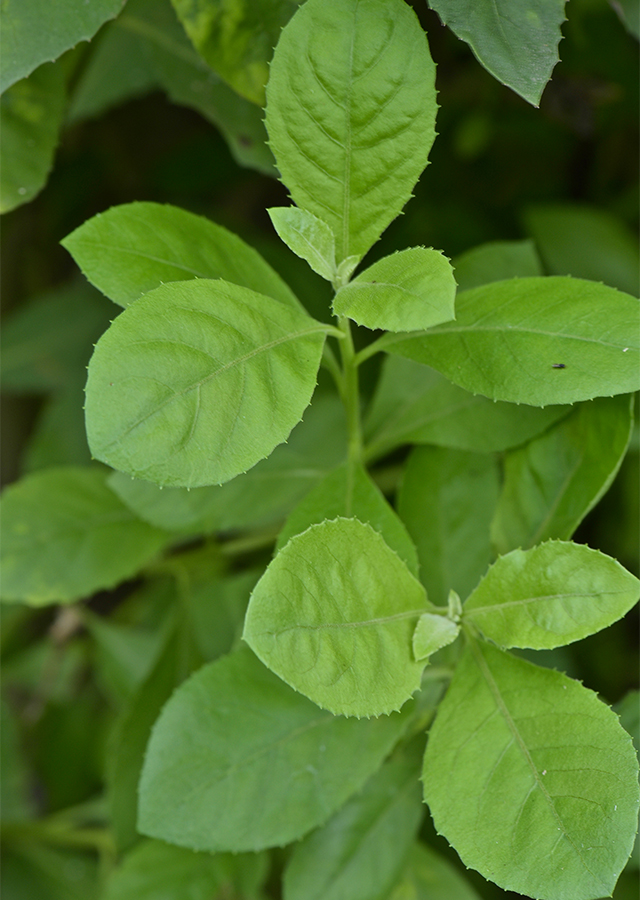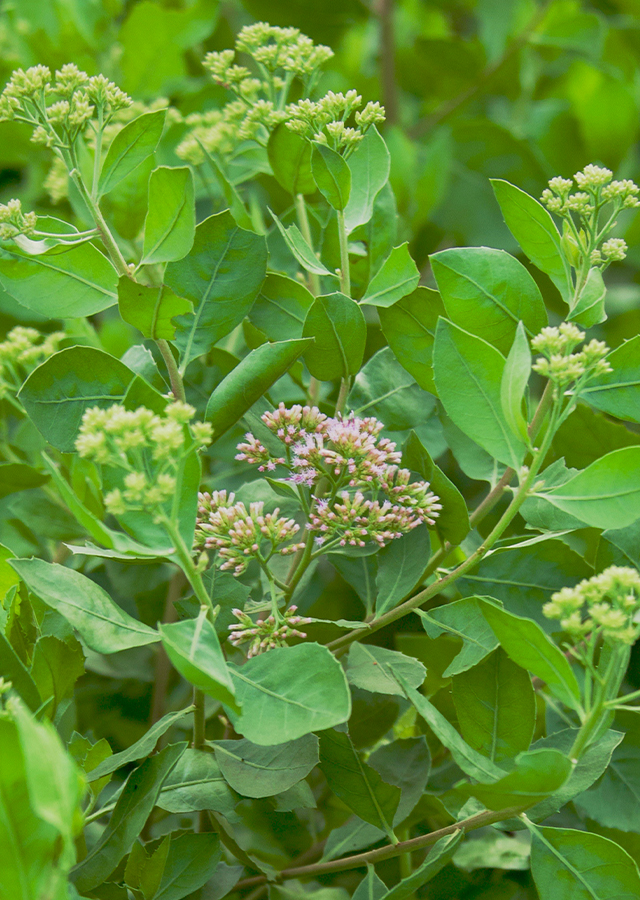Marsh Fleabane
Pluchea indica (L.) Less.
Asteraceae
Location in our garden
Principal



Synonym
Baccharis indica L.
Conyza indica Blume ex DC.
Placus indicus (L.) Baill.
Habitus
Shrubs. An evergreen, slender, erect, much-branched perennial shrub growing 1 to 3 m in height
Part Used
Leaves
Bark
Roots
Stem
Growing Requirements
Full Sunshine
Need Shade
Habitat
Wetland
Coastal
Overview
In 1915, Marsh fleabane was first collected in Hawaii and is native to Asia, China, Philippines, and Northern Australia, from India eastwards, and has become naturalized on several islands of the Pacific Ocean. It is one of Southeast Asia's most well-known indigenous medicinal plants and is traded locally, particularly for its use as a diuretic, provides edible leaves, and is grown as a hedge in gardens.
Vernacular Names
Kuo bao ju (Chinese), Indische puche (German), Kukronda (India), Hiiragi-giku (Japan), Kalapini (Philippines), Khlu (Thai), Lú’c cây (Vietnamese), and Beluntas (Indonesia).
Agroecology
In particular, Marsh fleabane occurs along the seashore, coastal streams, and swamps, on clay or hard and stony soils, often in sunny or slightly shaded areas near salt springs in the interior. It is grown as a hedge on fertile soil in the lower regions, often up to an altitude of 1,000 m.
Morphology
- Branches - cylindrical, woody, dark brown towards the green tip, glabrous but young shoots shortly hairy.
- Leaves - bright pale green, papery and almost glabrous, obovate, 2.5-8 cm × 1-5 cm, margins serrate, base attenuate, apex acute, and aromatic when crushed.
- Flowers - pink-purple or lilac, numerous. The inflorescence is a 5 to 11 cm long compound, terminal, slightly hairy corymb. Many heads are approximately 5 mm long. Involucral bracts are ovate, with increasingly longer inner bracts.
- Fruits - minute and ribbed, reddish-brown achenes. The pappus is white, scanty, and spreading
Cultivation
- Propagated by seed and stem cutting.
- Seedling with epigeal germination.
Chemical Constituents
Alkoloids, flavonoids, tannins, chlorogenic acid, monoterpen, sterols, multiflorenol, epipinoresinol, caffeic acid, benzaldehyde, uridine 5-monophosphate, quinones, essential oil (camphor, 'ALFA'-pinene, benzyl alcohol, benzyl acetate, eugenol, linalool and 'DELTA'-cadinol).
Traditional Medicinal Uses
Medicinal Uses
- The plant extract shows a diuretic effect related to the dosage.
- Roots and leaves are used as astringents and antipyretics.
- The extract of P. indica roots efficacy in exudative, proliferative, and chronic stages of inflammation.
- The essential oil is used as an antimicrobial.
- A new thiophene compound obtained from P. indica cultured plant has anticancer and cytotoxic effects against human leukemic cell lines.
Traditional Uses
- In Indo-China, a decoction of roots used in fevers as diaphoretic; infusion of leaves for lumbago.
- In Thailand, leaves are used as a nerve tonic and for treating inflammation. Decoction of bark used for hemorrhoids.
- In Indonesia and Malaysia, the leaves are also used as a stomachic, a galactagogue, and cough medicine.
- In Papua New Guinea, a decoction of the leaves and stem are drunk to ease asthma and other pulmonary problems.
- In Thai folk medicine, the stem is used for the treatment of kidney stones, hemorrhoids (bark), inflammation, lumbago, and leucorrhea (leaves). It is also used for the treatment of hypertension, diabetes mellitus, tumors, cystitis, and wounds. Decoction of roots or leaves used for treating fever, headaches, rheumatism, sprains, dysentery, dyspepsia, and in baths to treat scabies.
- In Lao folk medicine, for red and painful eyes from dust, lukewarm decoction of leaves used as eye wash.
Part Used
Reference Sources
- CABI. (2012). Invasive Species Compendium. Pluchea indica (Indian camphorweed). https://www.cabi.org/isc/datasheet/116400. 05-08-2020.
- Fern, K. (2019). Useful Tropical Plants Database. Pluchea indica (Linn.) Less. http://tropical.theferns.info/viewtropical.php?id=Pluchea+indica. 05-08-2020.
- Raharjo, I. & Horsten, S.F.A.J. (2016). Plant Use. PROSEA (Plant Resources of South-East Asia). Pluchea indica (PROSEA). https://uses.plantnet-project.org/en/Pluchea_indica_(PROSEA). 05-08-2020.
- StuartXchange. (2016). Philippines Medicinal Plants. Pluchea indica (Linn.) Less. http://www.stuartxchange.com/Kalapini.html 05-08-2020.


